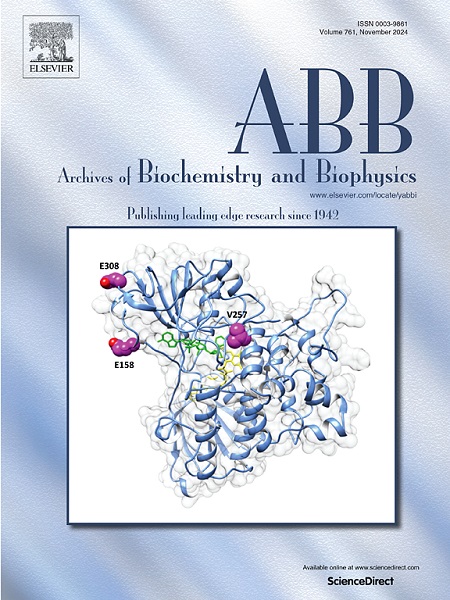The effects of indole-2,3-dione on radiosensitivity of U251 cells and zebrafish embryos
IF 3.8
3区 生物学
Q2 BIOCHEMISTRY & MOLECULAR BIOLOGY
引用次数: 0
Abstract
Radiotherapy is an effective treatment for gliomas, which are among the most malignant tumors in the central nervous system (CNS). A significant challenge in glioma radiotherapy is improving tumor control while minimizing damage to normal nervous tissue. In this study, we investigated the dual role of indole-2,3-dione (Isatin, ISA), a compound with diverse biological and pharmacological activities, including anticancer, antioxidant, and anti-inflammatory properties, in modulating radiosensitivity. The effects of ISA were examined in both human malignant glioblastoma U251 cells in vitro and zebrafish (Danio rerio) embryos in vivo. In U251 cells, irradiation significantly decreased cell viability and clonogenic capacity, while increasing reactive oxygen species (ROS) levels, inducing Cell cycle G2/M arrest, upregulating apoptotic gene expression, and inducing apoptosis. ISA pretreatment markedly enhanced these radiation-induced effects, potentiating clonogenic inhibition and proapoptotic activity. Moreover, combined ISA and irradiation treatment led to increased DNA damage and delayed DNA repair in U251 cells. In the in vivo zebrafish model, ISA pretreatment demonstrated significant radioprotective effects, reducing radiation-induced damage, including embryo mortality, behavioral alterations, ROS overproduction, and upregulation of proapoptotic genes. These findings suggest that ISA has dual functionality: acting as a radiosensitizer for glioblastoma cells and a radioprotector for normal CNS cells, primarily by modulating ROS production and apoptotic pathways. This study provides robust preclinical evidence supporting the potential clinical application of ISA in brain tumor radiotherapy, offering a promising approach to optimize therapeutic outcomes in glioma treatment.
吲哚-2,3-二酮对U251细胞和斑马鱼胚胎放射敏感性的影响
胶质瘤是中枢神经系统(CNS)中最恶性的肿瘤之一,放射治疗是治疗胶质瘤的有效方法。神经胶质瘤放射治疗的一个重大挑战是改善肿瘤控制,同时尽量减少对正常神经组织的损害。在这项研究中,我们研究了吲哚-2,3-二酮(Isatin, ISA),一种具有多种生物和药理活性的化合物,包括抗癌,抗氧化和抗炎特性,在调节辐射敏感性中的双重作用。在人恶性胶质母细胞瘤U251细胞体外和斑马鱼(Danio rerio)胚胎体内研究了ISA的作用。在U251细胞中,辐照显著降低细胞活力和克隆生成能力,同时增加活性氧(ROS)水平,诱导细胞周期G2/M阻滞,上调凋亡基因表达,诱导细胞凋亡。ISA预处理显著增强了这些辐射诱导效应,增强了克隆抑制和促凋亡活性。此外,ISA和辐照联合处理导致U251细胞DNA损伤增加,DNA修复延迟。在斑马鱼体内模型中,ISA预处理显示出显著的辐射保护作用,减少了辐射引起的损伤,包括胚胎死亡、行为改变、ROS过度产生和促凋亡基因上调。这些发现表明ISA具有双重功能:作为胶质母细胞瘤细胞的放射增敏剂和正常中枢神经系统细胞的放射保护剂,主要通过调节ROS的产生和凋亡途径。本研究提供了强有力的临床前证据,支持ISA在脑肿瘤放疗中的潜在临床应用,为优化胶质瘤治疗的治疗结果提供了一种有希望的方法。
本文章由计算机程序翻译,如有差异,请以英文原文为准。
求助全文
约1分钟内获得全文
求助全文
来源期刊

Archives of biochemistry and biophysics
生物-生化与分子生物学
CiteScore
7.40
自引率
0.00%
发文量
245
审稿时长
26 days
期刊介绍:
Archives of Biochemistry and Biophysics publishes quality original articles and reviews in the developing areas of biochemistry and biophysics.
Research Areas Include:
• Enzyme and protein structure, function, regulation. Folding, turnover, and post-translational processing
• Biological oxidations, free radical reactions, redox signaling, oxygenases, P450 reactions
• Signal transduction, receptors, membrane transport, intracellular signals. Cellular and integrated metabolism.
 求助内容:
求助内容: 应助结果提醒方式:
应助结果提醒方式:


